 USN Fleet Destroyers (1916-1947): USS Caldwell, Craven, Gwin, Conner, Stockton, Manley (DD-69-74)
USN Fleet Destroyers (1916-1947): USS Caldwell, Craven, Gwin, Conner, Stockton, Manley (DD-69-74)The Caldwell-class were six destroyers built for the United States Navy between 1916 and 1918. They were the first US Navy destroyers with the caracteristic “flush deck” hull design, the first US Navy destroyers to be equipped with geared steam turbines and with a new lozenge style artillery pattern.
These six ships were named after naval heroes, commissioned 1917-1918, and like the others used for ASW escort in Ireland and afterwards as training vessels in the interwar, the lead ship being discarded in 1936, one in 1939 but the others seeing action in WW2 under British colors. #ww2 #usn #usnavy #royalnavy #usdestroyer #caldwell #flushdecker
The first “flush-deckers”:
The Caldwell class marked a deep evolution of USN destroyer design, a true landmark. They inaugurated for the first time a brand new hull and the many innovations that went with it, a clear rupture with the linear evolution since the prewar Smith and Cassins.
Their origin lied in the Congress Act of 3 March 1915 which stated these destroyers were “to have a speed of not less than thirty knots per hour and to cost, exclusive of armor and armament, not to exceed $925,000.00 each… Provided, that three of said torpedo-boats herein authorized shall be built on the Pacific Coast.”. At the time indeed the Atlantic fleet was fell provided with a generous fleet of “1000-tonners”, leaving the Pacific fleet with obsolete vessels, and few destroyers in general. The admiralty already in 1915 envisioned to beef-up the Pacific fleet, since the rapid buildup of the Japanese Navy was something to be awere of. The US had not only Hawaii as advanced base, but also the Philippines, and apart gunboats, these local forces were ludicrously weak in case of any incident.
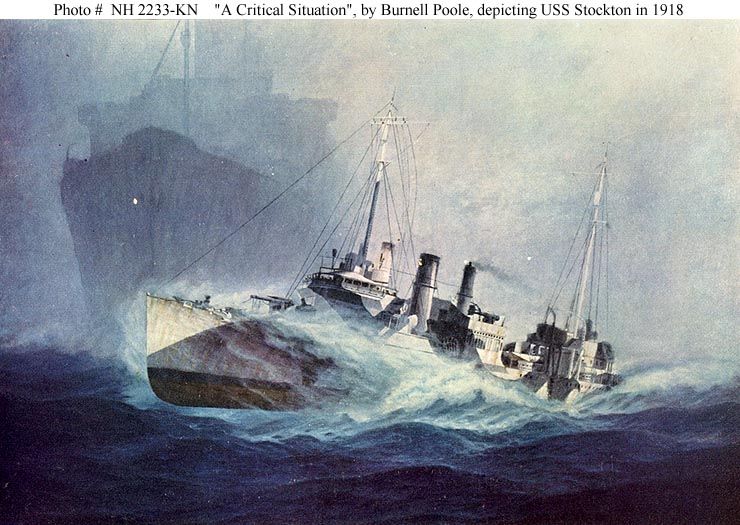
“A critical situation”, painting depicting the collision of USS Stockton in 1918
However since the bulk of th action still concentrated in the Atlantic, it’s where efforts were directed, at least until it was decided to discontinue the construction of “classic designs” and impose a new type of mass-produced vessel which could keep the same firepower, stay fast enough to escort the fleet’s battleships as the planned battlecruisers (Lexington class), have a better range for the Pacific, and still be cheaper to built.
So in early 1916, the back-and forth between the admiralty board and Bureau of Ships & Repair (BC&R) asked to create these new challenging designs, came up with a first design to be tested first on a “preserie” of six, the Caldwell class. They were to be the first of the following 279 ordered destroyers order (6 cancelled) in wartime, all based on this new design. In particular, the admiralty wanted to discard the traditional forecastle break, which was considered a structural weakness. Thus, compared to the Sampsons, even without touching on the powerplant and armament, the hull design was particularly cared for.

Clemson class plan: USS Doyen
To solve the structural issue, BuC&R came out with a straighforward solution, a flush-deck design, which posed a lot of design challenges of its own. Indeed, there are basically four kinds of flush-deck solution experimented by many Navy over the years, let’s have a look at these:
1-The “straight flush”: Simplest way, the upper deck was sloped by the height of a full deck level from the prow to the stern in order to preserve seakeeping forward
2-The “sheered flush”: The weather deck stayed flat for most of the lenght, then was sloped upwards gradually or in a streight way up to the bow on the forward section.
3-The “flat flush”: Another solution which consisted in having the same deck height forward and back, overall taller.
4-The “Stepped flush”: A way to decrease the deck height by sucessive steps from the prow to the stern.
The 1st solution was the one chosen by BuC&R (see below) as the simplest to built. The 2nd was seen for example on British WW1 cruisers such as the C and D class, with the same raised forecastle bow section. Many IJN ships also had a particular bow deck curve. The Pensacola class cruisers were also built that way as the German Hipper class.
The 3rd was the one retained on long-range cruisers such as the County class, and others.
The 4th solution was really only proper to the Japanese, on ships such as the Aoba/Furutaka classes, but also the following cruisers. It was rarely seen on destroyers.
The “straight flush” deck configuration was indeed simpler but imposed a serie of internal design revisions. The slope, given the lenght of the ship, was not considerable, about 5 degree, and thus nothing was changed to the inernals, which were sloped as a consequence. The real problem was when the lower decks met this sloped upper deck. A lot of internal volumes redistributions were to be rethought completely. So unlike the straightforward 1000-tonners like the later Sampson class, designers had to really find ways to rearrange all internal spaces to not loose any, and to cope with gravity changed, notably for piping water and steam up, etc. Ths imposed a lot of calculations, but the process started in March 1915, and the first ship, USS Coner, was really laid down only on 16 October 1916. So there had been 2.5 years of design refinements before finding a solution and make this complete design break.
Overall, the design as completed to be tested on the Caldwell left little time to gain experience: The Clemsons ships entered service in late 1917, even 1920 for USS Gwin, and the mass-construction class of the Wickes started right away, in late 1917, when none of the Clemsons hat time to make sea trials. There was a lot of trust put into this unproven design before starting such as massive industrial undertaking. As as we will see in the future, these new “flush deckers” had many problems of their own.
The Wickes and Clemson-class were basically a repeat design, somewhat slower (30–32 knots (56–59 km/h) vs. 35 knots (65 km/h)) and differing in details, notably the forward sheer of the Caldwell class was improved to keep the “A” mount from being constantly washed out, but without success. The Caldwells had a cutaway stern rather than the standard “cruiser stern” of the Wickes-Clemsons and this gave them a tighter turning radius, but these were costly solutions, not retained for mass production.
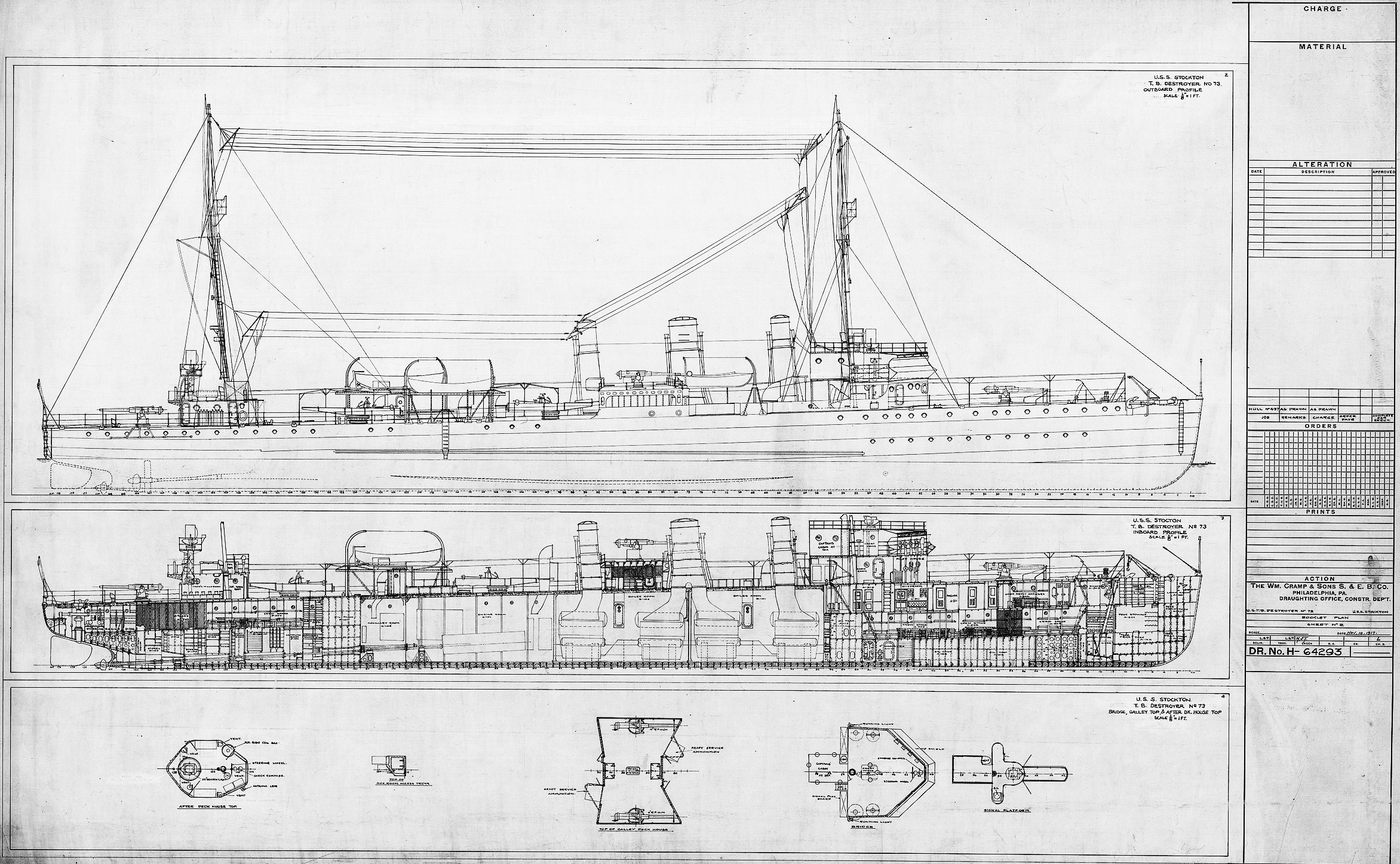
USS Stockton, booklet of plans
The armament was retained in order to keep some form of stability. The proving concept were the previous Sampsons, which innovative with four triple TT banks, AA guns, and the same old 4-inch (102 mm) guns. The main different is the way they were relocated:
Since the traditional 1000-tonners had them placed behind cutouts on the lower main deck, just after the forecastle cut, which was now eliminated, Engineers chosed to place them on “bandstands” aft of the bridge. The main advantage as to put them well above sea spray, unlike the previous designs. This was retained for the next ships, although still unable to bring more than a three gun broadside.
Internally, the appearance between the Caldwell class also diverged, USS Craven and Manley being “four-stackers” but USS Gwin, Coner and Stockton had three funnels, with a thicker, wider middle stack due to combined boiler uptakes. The Wickes/Clemsons, also for the sake of mass-production simplification stuck to a four identical funnels solution, being zlternatively called “four-stackers” in the interwar.
Detailed Design of the class
Hull and general design
The Caldwell-class destroyers had a 315 feet long long, with a beam of 30 feet, making them roomier, on a displacement of 1,090 tons, still not a radical departure from the traditional “1000-tonners”. They were also still armed with four 4-inch guns, two 3-inch anti-aircraft guns, and twelve 21-inch torpedo tubes as inaugurated with previous classes. They had a crew complement of 114 officers and men, and only really innovated in hull design, artillery and powerlant arrangements, which nevertheless was a lot for a single design within the rather conservative design practices of the time. If the hull was lightly larger and longer, the flush deck configuration also made the Clemsons lighter than the previous Sampsons, also a way to achieve greater speeds. They retained the same freeboard forward and aft as the “broken deckers” though, to keep seakeeping intact. Their shallow draft meant their propellers would not be deep enough and they were designed with a keel sloping aft.
Powerplant
Still somewhat experimental, the Caldwells tested various machinery systems. USS Coner and Stockton built by Cramp being the first two, followed the original design to the letter:
Three-shaft, direct drive steam turbines (The high-pressure turbine, center shaft exhausting into the two low-pressure turbines outboard). There was however a geared cruising turbine also on the center shaft for fuel economy, preserving range, and still producing a total output of 18,500 shp.
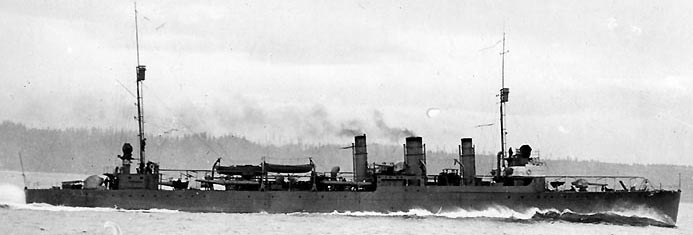
USS Gwin in speed trials
The remaining vessels had this simplified to two shafts, both with geared turbines, but no cruising turbines, for 20,000 shaft horsepower (14,900 kW) and a top speed going from 30 to 32 knots (56 to 59 km/h; 35 to 37 mph). Hence they answered the 1915 demand for faster destroyers as well. As a reminder, the Sampsons were ony capable of 29.5 kts, standard since the Pauldings in 1910.
Thus the second solution was adopted for the mass-produced Wickes-Clemsons.
USS Caldwell (part of this second serie) also experimented an “electric speed reducing gear”, to connect cruising turbines to the main turbines. It was a distant forerunner of the turbo-electric drive used on 1917-18 US battleships designs as well as aircraft carriers.
To be more precise, the ships also varied in boilers:
DD69 had two sets of Curtis geared steam turbines and four Thornycroft boilers
DD70 and 71 two sets of Parsons geared steam turbines and also four Thornycroft boilers
DD72 and 73 three Curtis steam turbines plis a geared steam turbine for cruising and four Yarrow boilers
DD74 had two sets of Parsons geared steam turbines and four Normand boilers
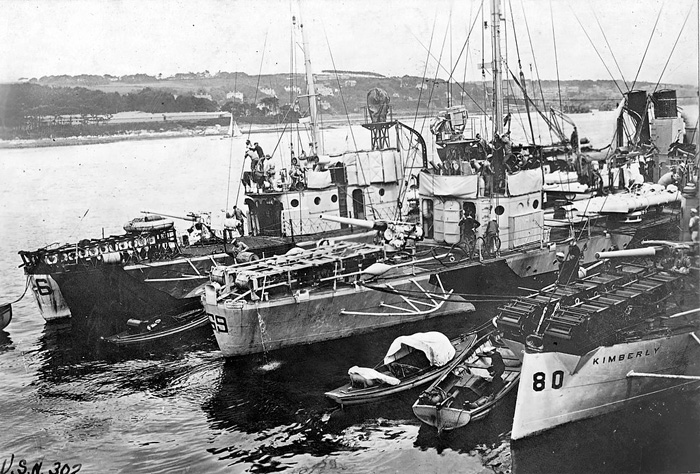
Change of speed, change of doctrine ?
It should be insisted on, that the jump from 29 to 35 knots (Wickes) top speed was enormous and opened a brand new range of possibilities for the US Navy.
Outside the US, the first to reach that treshold were the British flotilla leaders of the Lightfoote class, also “four stackers”, which made 34,5 knots in late 1915. This was greater than average destroyers of the time, although the “regular” M-class launched in 1914 were capable of 35 knots already. Contemporaries of the Clemsons, the Scott class flotilla leaders reached 36 kts and the mass-built V-W classes 34. The German B97 class reached more than 36 knots, as the large S113 of the end of the war as much. IJN destroyers such as the Minekaze and following designs were tailored for no less than 39 kts. This new average limit of 36 kts seems indeed the new standard for destroyers, but left these new US destroyers still a knot below average.
Armament
Guns: 4x 4-in/50 Mark.
The 4-inch (102 mm)/50 Mark 9 guns were kept from previous designs.
Specs: Weight 6,100 pounds (2,800 kg), 33-pound (15 kg) armor-piercing shells (2,900 feet per second or 880 m/s) range 15,920 yards (14,560 m) at 20°. They were placed still in a lozenge pattern, one axial forward, one aft, both axial, and the last two on an upper position amidsgips, “bandstands” aft of the bridge. They were left unshielded, but rigid shields were installed in some case from 1917 and canvas for the remainder. The game changer was this upper relocation made these broadside guns inensitive to water spray. However the absence of forecastle made the formward gun “wet” most od the time while in heavy weather.
More on navweaps.com
Torpedoes: 4×3 21-in Mk. 8
As the Sampsons, the new destroyer kept the same impressive combination of twelve torpedo tobes in four triple banks, two on each broadside. These tubes were loaded with Bliss-leavitt 21-inches Mark 8 Torpedoes (1915). There were no reloads. in WW2 given the same configuration of interwar USN destroyers such as the Mahan class (16 tubes), new techniques to fire new preset-circular pattern torpedoes gave opened new possibilities. But for the three ships that were sent to the RN, they were used for escort and two of the banks were removed (see later).
Characteristics:
The Mods 0, 1, 2 or 2A weighted 2,761 lbs. (1,252 kg), 248 in (6.299 m) long, 321 lbs. (146 kg) TNT charge, settings 10,000 or 12,500 yards (9,140 or 11,430 m) at 27 knots. Powered by Wet-heater and guided by a Mark 8 Mod 1 gyro. The tube banks were staggered for better arcs of fire, located amidships and aft of the funnels, with the port ones closer to the bow. They faced forward and aft depending on their location, but with limited traverse.
AA Guns: 2x 1-pdr Mk.7
These autocannons were placed for and aft, one behind the main gun, at the feet of the bridge, the other superfiring above the aft gun from the quartedeck. Based on the British 1-pdr QF “pompom”. Maxim-Nordenfelt 37 mm 1-pounder Mark 6/7. This was the lineage of the first dedicated anti-aircraft guns adopted by the US Navy, until replacement by the 3 in/23.
Quickspecs: Automatic fire with recoil, ~300 rpm cyclic, belt-fed, mv 1,800 ft/s (550 m/s) range c4,000 yards.
In the 1930s they all received 1930s two Browning 12.7mm/90 hevay macihine guns for AA defence instead of their 1-pdrs. Of course they were removed when modernized.
Armament upgrades and changes
Already the ships varied between themselves in service:
DD69 and 72-74 had the four 102mm/50 Mk IX and 2x 37mm/43 Mk VI/VII precised above, plus their four triple 533mm TT and two DCR (depth charge racks)
DD70 and 71 had the same but one DCT (depth charge thrower or “Y-Gun”) and 2 DCR.
In 1918 all had their 37 mm removed and two 76mm/23 (3-in) Mk XIV guns installed instead. They kept them for the whole interwar.
Caldwell, Coner, Stockton and Manley received also a Y-Gun in 1918.
In the 1930s one 3-in (76mm/23) was removed and two 12.7mm/90 or 0.5-in cal. Browning M1920 HMG were added.
In 1938-1939 at New York NYd, USS Manley was converted as the prototype of fast transport (APD), armed with three 4-in/50 Mk 9 guns (aft one discarded) four single 0.5-in/90 Browning AA and four DCT, 2 DCR. She could carry under favits four LCP(L) or LCP(R) and 120 troops. Her machinery was reduced by half for added range and useful space for the troops. In addition to the their ASW armament, USS Manley received a QCJ sonar.
The ships will be seen more in detail in a future APD conversion article.
In 1942-1944 she would have all her 4-in/50 guns and four Bprnwing AA removed and instead, three 3-in/50 Mk 20 DP guns, a twin 40mm/56 Mk 1.2 Bofors mount installed, and five single 20mm/70 Mk 4, Oerlikon AA guns and presumably an SA, and SE radars.
About the Leeds class
Three ships entered service with the RN as part of the 50 ships deliverd via lend-lease in 1940. These were DD-70 (Craven) as HMS Lewes, DD-72 Coner as HMS Leeds and DD-73 Stockton as HMS Ludlow, all three recommissioned on 23 October 1940. As delivered, they had the new 3-in/23 Mk 14 DP guns and three 0.5-in (12.7mm) Browning AA, plus two DCR. They were refitted with a type 141 sonar and underwent considerable changes during their carrer:
By late late 1940 one 4-in/50 was remived as well as a single 3-in/23, and two of the 21-in TT banks. This was traded for a more modern 5-in/50 Mk 10.19/20, four DCT, and DC stowage increased up to 60 depth charges.
In 1941-1942 they were fitted with a type 271 and type 286 radars.
Later HMS leeds lost two more of her 4-in/50 and the remaining TTs, for two single 3-in/50 Mk 10.19/20 and two 20mm/70 Oerlikon Mk II/IV AA guns.
This was repeated on Lewes and Ludlow, which however gained two twin 40/39 2pdr QF Mk VIII. The type 291 radar was installed before 1944 and one more 20mm/70 Oerlikon Mk II/IV.
At the end of the war, HMS Lewes had two 40mm/39 Mk VIII, five 20mm/70 Mk III, 4 DCT, 2 DCR (60 DCs) as well as the type 271, type 286 or type 291 radars and original type 141 sonar.
HMS Leeds had the same configuration. HMS Leeds ended BU on 3.1947 whereas Lewes was sunk as target on 25.5.1946 and Ludlow on 15.7.1945.
Appearance, Profiles and camo:

USS Conner painted with the Mackay low visibility scheme in 1918. Also called “Disruptive Coloration” or “Low Visibility-Dazzle” System. It combined many colors, including pink and greens, as well as wavy lines, patches, and spots. The latter were its most prominent aspect. The two ships of the class known to have it wore a complicated “chekered” pattern. The other wore the traditional light grey/black lines scheme.
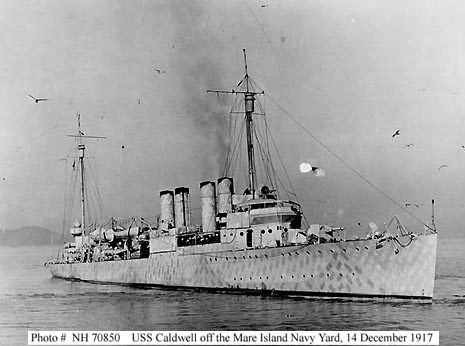
USS Caldwell at Mare Island in 1917 with the same camouflage. Colors are known to have been blue, greens, and pink. See also.
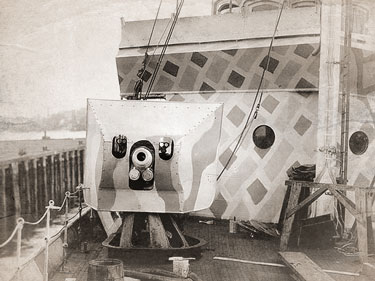 USS Isabel showing a more precise version of this pattern, alternated lozenges in possibly pink and blue-green and other colors of the same tone, separated by white outlines in a checkered pattern. William Andrew Mackay was an American muralist which became a reputed “camoufleur” from his studio in New York. He attempted to achieve low visibility by using small splotches of color in the “Pointilist” art trend, and they produced at a great distance a “nondescript ambient gray” less discernible than the classic “battleship gray.” It was combined with disruptive patterns, breaking the shape of the ship, sense of direction and angle.
USS Isabel showing a more precise version of this pattern, alternated lozenges in possibly pink and blue-green and other colors of the same tone, separated by white outlines in a checkered pattern. William Andrew Mackay was an American muralist which became a reputed “camoufleur” from his studio in New York. He attempted to achieve low visibility by using small splotches of color in the “Pointilist” art trend, and they produced at a great distance a “nondescript ambient gray” less discernible than the classic “battleship gray.” It was combined with disruptive patterns, breaking the shape of the ship, sense of direction and angle.
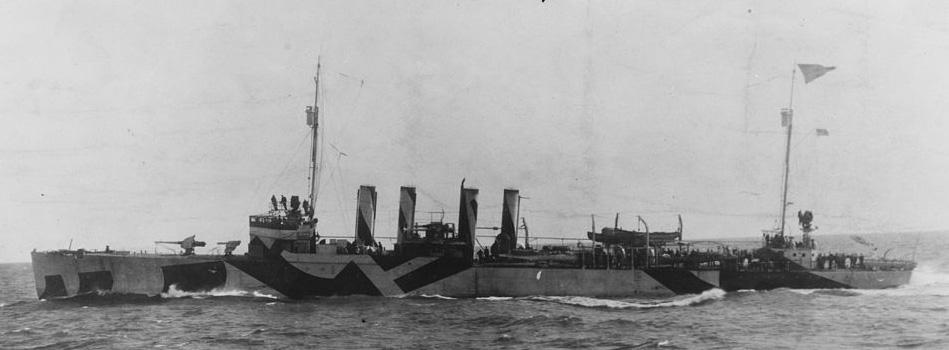
USS Craven underway in November 1918, with the classic disruptive black and grey pattern.
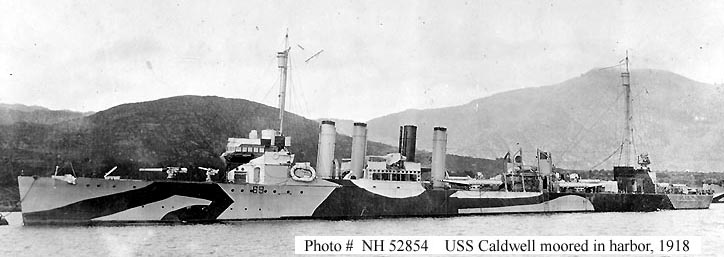
USS Caldwell at the same time, with the same variant.
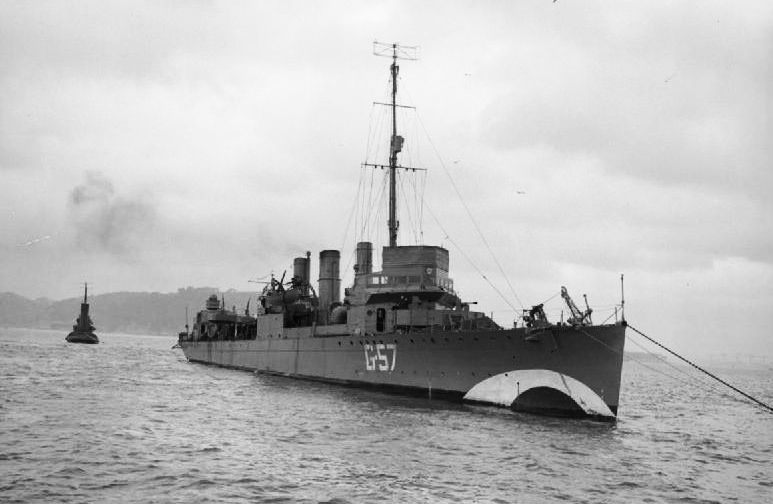
In British service: USS Ludlow just arrived, with a prominent fake bow wave. To see another later example, check the dedicated article below.
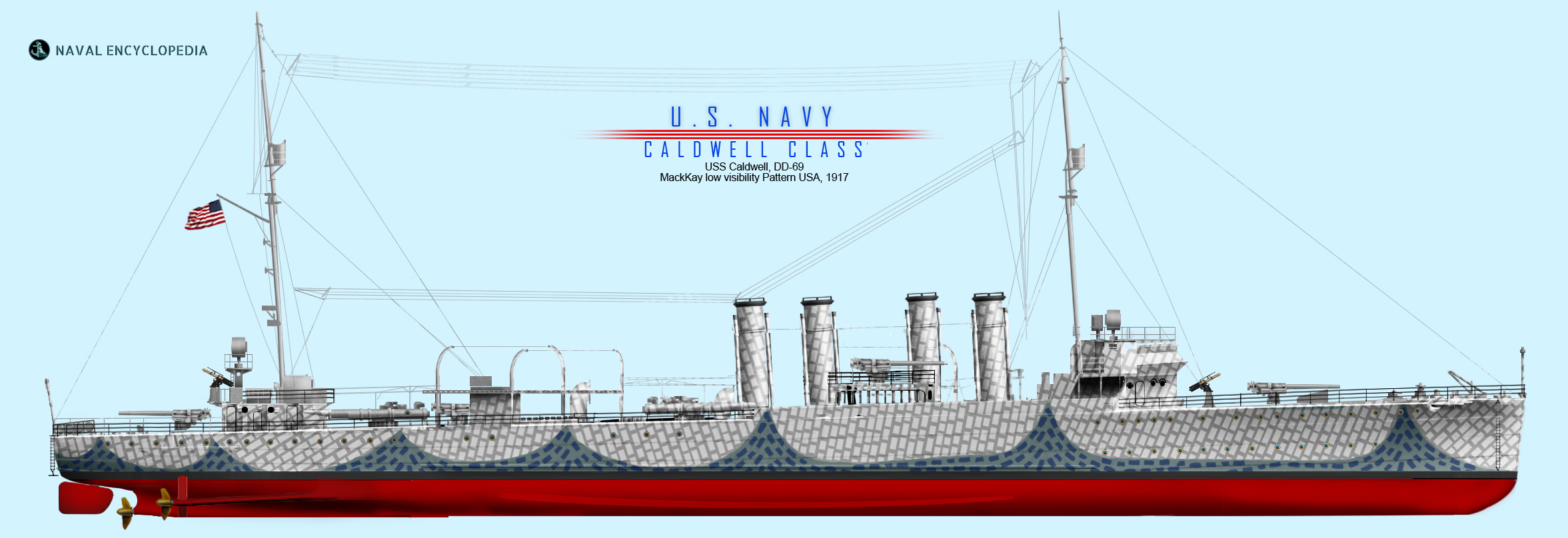
USS Caldwell in 1917 with her remarkable McKay LV camouflage
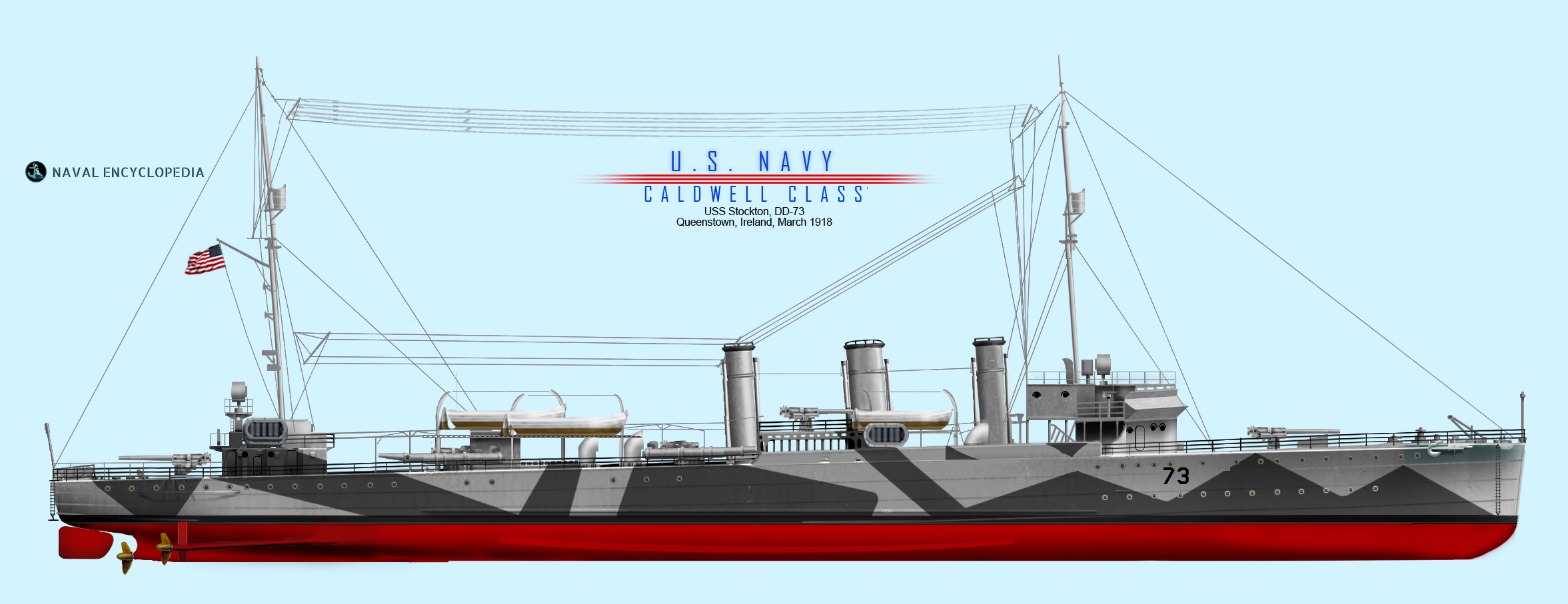
USS Stockton in 1918

HMS Ludlow in 1942
⚙ specifications |
|
| Displacement | 1,020 tons normal 1,125 tonsFL or 1,125 tons normal, 1,187 tons FL |
| Dimensions | 308/315 ft 6 in x 31 ft 3 in x 11 ft 6 in* (96.16 x 9.53 x 3.51 m) |
| Propulsion | 2 shafts G.E./Curtis Turbines/Parsons/White-Forster turbines 18,500-20,000 shp, see notes |
| Speed | DD 69-71, 74: 32 kn – DD 72-73: 30 kn, 31.7 best trials |
| Range | Circa 2500 nm/10 kts ? |
| Armament | 4× 4-in/50, 2× 1-pdr AA guns, 4×3 21 in (533 mm) TTs |
| Crew | 8 Officers, 8 Chief Petty Officers, 106 Enlisted |
*315′ 6″ x 310′ x 30′ 8″/8′ 0 1/2″ mean
Read More
Books
Friedman, Norman (2004). US Destroyers: An Illustrated Design History (Revised ed.). Annapolis: Naval Institute Press. ISBN 1-55750-442-3.
Gardiner, Robert, Conway’s All the World’s Fighting Ships 1906-1921, London: Conway Maritime Press, 1985. ISBN 0-85177-245-5.
Gardiner, Robert and Chesneau, Roger, Conway’s All the World’s Fighting Ships 1922-1946, London: Conway Maritime Press, 1980. ISBN 0-83170-303-2.
Jane’s Fighting Ships of World War I. London: Random House Group, Ltd. 2001. p. 147. ISBN 1-85170-378-0.
Campbell, John (1985). Naval Weapons of World War Two. Naval Institute Press. ISBN 0-87021-459-4.
Fitzsimons, Bernard, General Editor. The Encyclopedia of 20th Century Weapons and Warfare, Volume 5, pp. 510–11, “Caldwell”, and Volume 16, pp. 1717–18, “Leeds”. London: Phoebus, 1978.
Silverstone, Paul H., U.S. Warships of World War I (Ian Allan, 1970), ISBN 0-71100-095-6.
Silverstone, Paul H., U.S. Warships of World War II (Ian Allan, 1965), ISBN 0-87021-773-9.
Links
historyofwar.org/
on history.navy.mil/
on globalsecurity.org/
on ibiblio.org/hyperwar/
on history.navy.mil
destroyerhistory.org/
https://destroyerhistory.org/: uss craven
destroyerhistory.org/ uss manley/
navypedia.org/ caldwell class RN
navypedia.org/ caldwell.htm
On wikipedia.org
commons.wikimedia.org/
history.navy.mil/ uss-manley-dd-74-ag-28-apd-1.html
Model Kits
Book: modelwarships.com/ dd-inaction1.html
No kit four so far
 USS Caldwell (DD-69)
USS Caldwell (DD-69)

USS Caldwell was launched 10 July 1917 at Mare Island Navy Yard, commissioned 1 December 1917 under command of Lieutenant Commander B. McCandless, and first USN ship named for Lieutenant James R. Caldwell (1778-1804). Assigned to thr Atlantic Fleet, she was based in Norfolk from 8 January 1918. After quick training she was sent to Queenstown, Ireland, arriving on 5 March 1918, early enough to participating in the last wartime patrol and convoy escort missions. They were interrupted as Caldwell helped an experiment of underwater listening devices inder to to equip the allies fleet and better deal with German submarines. In December, USS Caldwell carried troops to Brest in France and joined the escort for President Woodrow Wilson, on SS George Washington en route for the meace taks in Paris.
She returned home as part of the Norfolk Division, Destroyer Force (Atlantic Fleet), assigned to Destroyer Squadron 3 (DesRon 3) operating along the East Coast until the end of 1919. Placed in reserve in August 1920, like many othjer DDs she operated with reduced complement from Charleston, and later Newport in Rhode Island. She waseventually decommissioned at Philadelphia Navy Yard on 27 June 1922, seeing very little active service. She was not revised for Coast Guard Patols (none of her class did), and instead was was sold for BU on 30 June 1936, the first of the class to be discarded.
 USS Craven (DD-70)
USS Craven (DD-70)
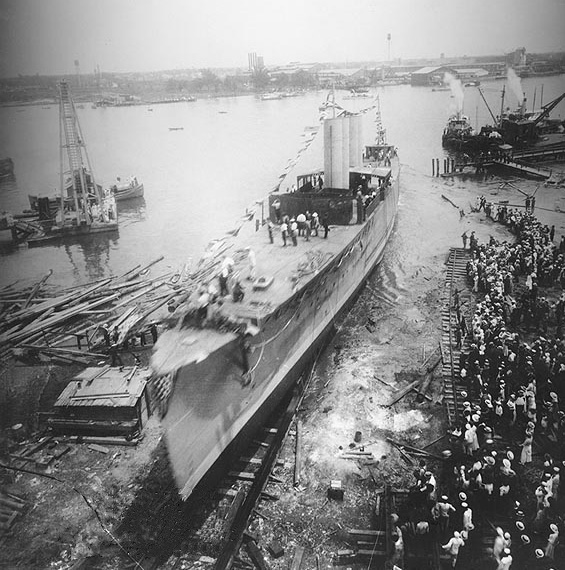
Launch of USS Craven
She was the second ship of the name, after Commander Tunis Craven (1813–1864). Buil at Norfolk Navy Yard, Portsmouth, Virginia, started by 20 November 1917, launched on 29 June 1918 she was commissioned on 19 October 1918. This left her little time to train. Still, she had a long career, and what she missed in WWI, she would make it for in WW2 like three others in her class.
US Navy career
USS Craven trained off the East Coast and Caribbean, also performed torpedo practice as the war ended, and on 3 May 1919 she sailed from New York for Trepassey Bay in Newfoundland, to act as a weather station, tracking Navy seaplanes for a historic crossing of the Atlantic. She was later overhauled and used for Army gun tests at Fort Story in Virginia. Newt she was used as recruitment ship at Hampton Roads, and later at Fall River (Massachusetts) and then Newport in Rhode Island and placed in reserve in Philadelphia on 10 October 1919.

Place in reduced commission she was in service from Charleston (South Carolina) from 10 February 1921, carrying liberty parties between Charleston and Jacksonville, and taking part in fleet maneuvers off Virginia, Narragansett Bay until March 1922. Deactivated in Phuladelphia she was decommissioned by 15 June 1922, mothballed long term.
On 12 November 1939 however she had not been scrapped. Since the name USS Craven has been given to a new destroyer (DD-382), she was recommissioned as USS Conway (after William Conway (1802–1865). From 9 August 1940 she was in limited service, until she was selected for transfer to the RN as part of the presidential lease of 50 destroyers, to recoup the losses in destroyers at the time the Battle of the Atlantic was fierce. She was sent to Halifax on 17 October 1940, Nova Scotia and decommissioned for good from US service on 23 October 1940.
As HMS Lewes, RN

USS Conway was turned over to British authorities as part of the “Destroyers for Bases” Agreement and recommissioned as HMS Lewes (East Sussex, England) a town like the 50 Wickes-Clemsons tranferred and named globally the same way. She had also the British pennant G 68 on 23 October, was prepared and departed Halifax on 1 November for Belfast, Northern Ireland, arriving eight days later.
Her first mission was to look for KMS Admiral Scheer trying to get into the northern Atlantic by the norther route. Missing her, she was sent next to Plymouth for modifications and overhaul. She remained afterward on disposal of CiC Plymouth. Air raids on 21 and 22 April 1941 saw her badly damaged. She was repaired until December 1941.
By February 1942, she was deployed with the Rosyth Escort Force, guarding convoys between the Thames and Firth of Forth. On 9-10 November she spotted engaged German S-boats attacked the convoy off Lowestoft. Later she escorted a troop convoy to the Middle East. At her return she was sent to Simonstown, South Africa, arriving on 18 May 1943. Due to her age she was reused as a target ship for aircraft while keep patrolling for enemy submarines trying to round the Cape.
In 1944, she was reassigned to the Eastern Fleet, but as submarine tender/torpedo target ship. From Durban on 13 August, she arrived at Ceylon in September, and was based at Trincomalee (Ceylon) in her new role, until January 1945. Ttransferred to the British Pacific Fleet, she again acted as target ship for aviation. Sent to Fremantle (Australia) by 11 February 1945, then Sydney on the 20th, she remained there until the end of the war on 15 August. On 12 October 1945, she was declared surplus and stripped off, then used as target and scuttled in the Tasman Sea (off Sydney) on 25 May 1946.
 USS Gwin (DD-71)
USS Gwin (DD-71)

USS Gwin (second Navy named for Lieutenant Commander William Gwin) was launched on 22 December 1917 at the Seattle Construction & Drydock Co. (Washington) and commissioned at Puget Sound Navy Yard in Bremerton, Washington, on 18 March 1920, expected for a Pacific service, but missing WWI altogether.
Departing Puget Sound on 26 April 1920 she made her shakedown along the Californian coast, crossed the Panama Canal for Newport (arrived 2 June 1920) and hoined operations along the East Coast down to Charleston. She was decommissioned at Philadelphia Navy Yard on 28 June 1922. She was mothballed, inactive until stricken on 25 January 1937, sold for BU to Union Shipbuilding, Baltimore, on 16 March 1939.
 USS Conner (DD-72)
USS Conner (DD-72)

USS Conner in 1918
USS Conner was built at Engine Building Company at Philadelphia, commissioned on 12 January 1918.
USN service
Conner sailed from New York City on 12 May 1918, after her sea trials, shakedown and initial training, to escort a convoy to the Azores and Brest in France. From there she escorted convoys inbound to British and French ports, and those outbound up for Bermuda. Like her sisters active in WWI she alternated between answering calls and rescuing crews twice in July, and hunting down for U-Boats after sightings. By November, she made mail and passenger runs between Brest and Plymouth. From 8 May 1919 she was in Plymouth, and sortied to escort SS Lincoln to Brest for the Paris Peace Conference.
Back home, USS Conner joined fleet maneuvers in Narragansett Bay in July-August 1919 and was overhauled at the Philadelphia Navy Yard from 4 October 1919. She was placed in reserve at Norfolk, until May 1921, participating in large-scale fleet exercises. Based in Newport she started training with submarines. Until 29 March 1922 she was based in Charleston, until sent to Philadelphia to be decommissioned on 21 June 1922. Unlike two of her sister she was not stricken and sold for scrap. Instead, she was still avilable in 1940.
In July the US Navy had her recommissioned and rearmed as an escort vessel with only two torpedo tubes banks, the aft 4-inch gun relaced by a single 3-in/50 DP gun, when notified as part of the 50 destroyers transferred to the RN, recommissioned on 23 August 1940, refitted at Philadelphia and sent afterwards to Halifax, Nova Scotia, to be decommissioned for transfer on 23 October 1940.
RN service as HMS Leeds
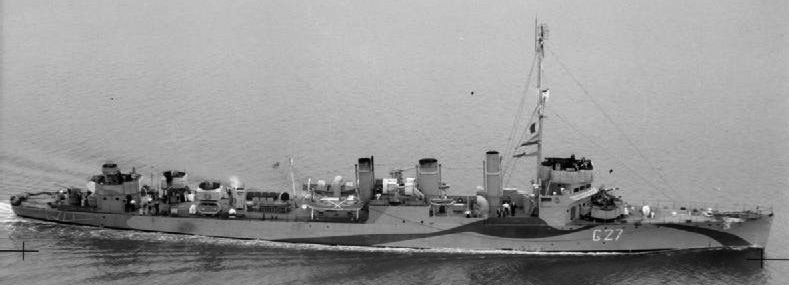
The same day she was recommissioned with a British crew as HMS leeds. She left Halifax on 1 November 1940 for Belfast, placed Under the Rosyth Command. She started her escorted work in the North Sea (Thames-Firth of Forth) and underwent two air attacks. On 20 April 1942 she helped and assisted the badly damaged HMS Cotswold and towed her into Harwich. During the night of 24–25 February 1944 she also helped to repel German S-Boote attacks. By April 1945 she was placed in reserve, at Grangemouth, Firth of Forth (Scotland) and sold for scrap on 4 March 1947, BU, the last ship of the Caldwell class to disappear.
 USS Stockton (DD-73)
USS Stockton (DD-73)
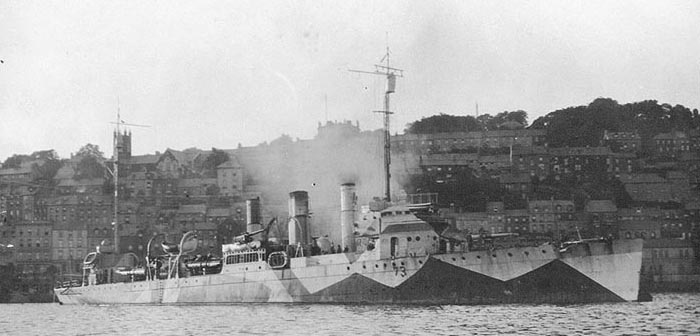
In US service
USS Stockton was built at William Cramp & Sons at Philadelphia, launched on 17 July 1917, and commissioned on 26 November 1917. She spent the last year of the war escorting convoys from Queenstown in Ireland, spotted and one day engaged an U-boat but failed to sink her. On 30 March 1918 with USS Ericsson she was escorting the troopship St. Paul between Queenstown and Liverpool when Ericsson opened fired on a U-Boat which submerged and launched a torpedo at USS Stockton, which narrowly evaded it. The two destroyers depth charged the U-boat, but the latter escaped. During that night however when manoeuvering, USS Stockton passed in front of the ferry Slieve Bloom, near South Stack Light. The latter sank on 31 March 1918 after the collision while Stockton was stuck in Liverpool for repairs until the end of the war.
USS Stockton returned home in 1919 but went on in limited service with the Atlantic fleet until 26 June 1922, decommissioned and mothballed in Philadelphia. Still extant in 1940, she was selected for transfer, recommissioned on 16 August, proceeded to Halifax, decommissioned on the 23th and transferred the same day to the RN. More than a loan this was a gift, and she was stricken from the USN register by 1941.
RN service as HMS Ludlow

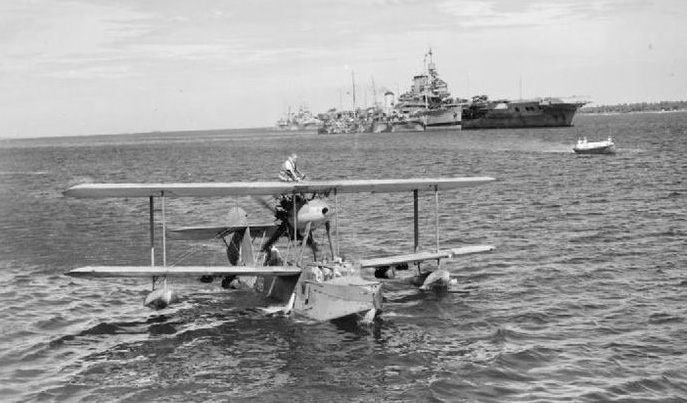
HMS Ludlow in escort work. One photo shows her camouflage in 1942, the second in the background screeing HMS Illustrious. This was one of her frontline duties.
As HMS Ludlow (G57) she multiplied escort missions. She was decommissioned by June 1945, beached in the Firth of Forth (off Yellowcraigs beach) to be used from 15 July 1945 for rocket target to train RAF pilots. It was reported the first below the waterline sank her. Her wreck is still there, just under 20 ft of water, some remains still visible at low tide.
 USS Manley (DD-74)
USS Manley (DD-74)
First career 1917-1922
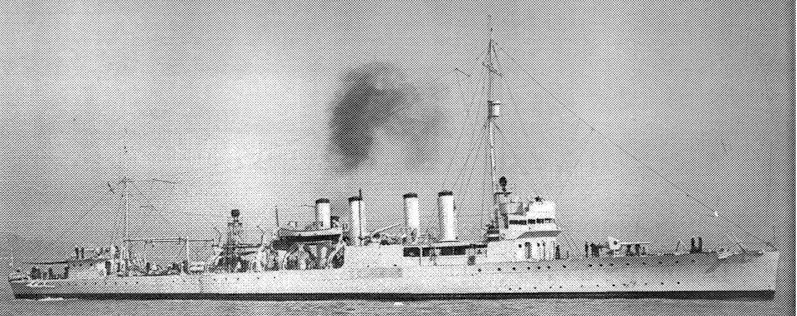
Probably of all ships in this class, USS Manley is the one with the most interesting career. Second to be named after Captain John Manley (c.1733–1793) she was built at Bath Iron Works in Maine, launched on 23 August 1917 and commissioned on 15 October 1917. After fitting out in Boston she sailed with Battleship Division Nine (BatDiv 9) on 25 November 1917 to Queenstown in Ireland. She escort her first convoy from there on 19 March 1918, when she rolled against the British auxiliary cruiser HMS Montagua, and the collision was enough to detonate her own depth charges, loosing her stern as well as 33 enlisted men and XO Lt. Comdr. Richard M. Elliot Jr. To add to the misery, fragments pierced two 50-US-gallon drums of gasoline and two 100 US Gal. tanks of alcohol which leaked and caught fire along the deck. The crew saved the ship from certain doom, working late into the night.
She was later towed by the sloop HMS Tamarisk and the the Blazer and Cartmel on 20 March back to Queenstown. She was flooded enough to have just 70 feet (21 m) of her hull under water. Repairs in Liverpool were only completed on 22 December 1918 and she was prepared for home, to participate in east coast exercizes. Instead she trained on the eastern seabourne and on 11 April 1919 was sent t the Mediterranean and Adriatic Sea transporting passengers, mail, a small diplomatic staff. By June 1919 she did the same with the U.S. Food Commission in Turkish ports, and in Black Sea. After this unusual cruise she was back to New York on 1 August 1919, decommissioned at Philadelphia on 14 June 1922.
Second career 1930-40
Unlike her sisters she recommissioned on 1 May 1930 to experiment new torpedo-firing tubes based in Newport, Rhode Island. On 19 August she trained with the Scouting Fleet (battle practice) along the eastern seaboard and Caribbean. After crossing the Panama canal she did the same off California, based in San Diego, in 1932. Back to Atlantic service in 1933 she went on in the same testing routine until sailing to Panama on 10 September 1935, joining the Special Service Squadron that patrolling the Caribbean.

USS Erie, Jacob Jones and Manley training midshipmen in the summer of 1937
She was based in Norfolk by February 1937, reassigned to DesRon 10 for training midshipmen. On 26 October 1937 she left Boston with USS Claxton to join Squadron 40-T, protecting US interests in the Mediterranean, as the Spanish Civil War was raging. She operated from Villefranche (France) Naples (Italy) Algiers and Tangiers in French North Africa until relocated to Gibraltar and departing on 29 October 1938 for home, Norfolk. Reclassified a miscellaneous auxiliary on 28 November, redesignated AG-28 the Navy intended to convert her as their first auxiliary and high-speed transport prototype, in order to convert other Wickes/Clemson ships, now obsolete destroyers, since they were all related.
Third career as an APD (WW2)
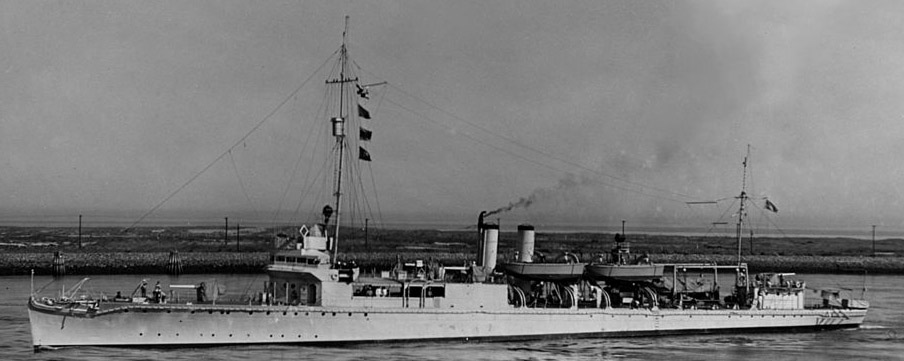
USS Manley as APD-1 as completed, 23 September 1940.
USS Manley was transformed into an experimental high-speed transport at the New York Navy Yard, completed on 7 February 1939. She made a first marine landing on 21 February from Target Bay, Culebra Island and went on making others along the Virginian and North Carolina beaches and Caribbean, proving the concept well before the war. USS Manley visited California by the spring of 1940 for others drills off Coronado Roads and back on the Atlantic she was redesigned APD-1, as the first operational high-speed transport on 2 August 1940. The team behind with the war ongoing knew that she was a very useful experiment.
Apart training, Manley was used as escort in the Atlantic, first through neutrality patrols, and then in wartime for the US. On 11 April 1942 Manley picked up 290 survivors from SS Ulysses. On she transited the Panama Canal, reporting to the Pacific Fleet, headong for the Fiji and Espiritu Santo in the New Hebrides on 14 August to load equipment for the post-landings phase at Guadalcanal missed by just a week.
She carried bombs, ammunition, and gasoline and sailed with USS Stringham (DD-83) on 16 August, exchanging her cargo for wounded marines, steaming back to Espiritu Santo. She later took in tow the crippled USS Blue (DD-387) to Tulagi but as Japanese were reported coming, it was decided to scuttle the destroyer instead and Manley evacuated the survivors, reaching Espiritu with just two hours of fuel left.
There, she received the mission of sneaking in reinforcements and supplies to Guadalcanal: Her crew removed all topside weight, the non-essential and she was (also the first) painted in jungle green (the first of the famous “green dragons”), superstructures covered by camouflage nets. She made her trip to Guadalcanal on 3 September, rescuing survivors from the APDs Little and Gregory on the 5-6th.
Camouflage patterns fo APD-1, measure 31 12T and 20L
On the 8th at 05:00, she made a surprise landing on Taivu Point, Guadalcanal (1st Marine Raider Battalion), reinforced by paramarines at 11:30. She also bombarded a theior demand the Tasimboko village. The raid was a success which prepared the Marine’s victory in the area. The village was an imporetant Japanese supply base, crammed with supplies and ammunitions, all destroyed. Manley was back to Lunga Point later with more raiders when informed of an impending Japanese heavy ships raid. With 200 marines aboard, she steamed to Lengo Channel with USS McKean (DD-90), but only had fuel for one day’s operations and so headed for Tulagi. ext she was sent to Nouméa in New Caledonia for a refit.
On 31 October 1942 she landed another Marines raider company at Aola Bay in Guadalcanal as part of TF 65 effort, with another on 4 November 1942 and on the 8th. She resupplied at Nouméa on 20 November and came back with torpedoes and towing two PT boats while escorting SS Pomona back to Espiritu Santo. She landed raiders at Lunga Point as well as the boats and torpedoes to Tulagi. The next weeks and months were occupied by the same routine of supply runs though the Solomons.
At last, the worn out veteran was sent for a major overhaul at San Francisco on 12 June 1943. She emerged from Hunters Point Navy Yard on 1 August 1943, bound for Hawaii and escorting a convoy south to Funafuti, Solomons. The campaign there was a win, and she contributed greatly to it.
Back at Pearl Harbor on 14 December 1943 she joined the Vth Amphibious Corps prepared for Operation Flintlock (Marshalls). She was underway on 22 January 1944 with TF 52 and detached with USS Overton (DD-239) for a dawn strike on Carter and Cecil Islands (Kwajalein Atoll) on 31 January. Both were taken.
Next she landed the 7th Cavalry Regiment (reconnaissance troops) on Bennett Islands on 5 February and acted as fire support ship. On the 10th, she was a transport screen for Hawaii and trained there Army troops for future landings.
On 30 May, USS Manley was assigtned to TG 52.15 and took part in the invasion of Saipan, arriving on 14 June, landing troops south of Garapan on the 16th and made a supply run to and from Eniwetok while bombarding Tinian on the 9, 12, and 18 July. On the 22th she was back at FOB Eniwetok and via Kwajalein, she arrived in Pearl Harbor on 9 August. On 10 September she carried 50 tons of explosives for the underwater demolition team work prepared for the invasion of Yap. departing on the 15th via Eniwetok hea arrived off Manus, Admiralty Islands. She learned the operation was canceled and instead attacked Leyte, Philippines, doubling as a fire support mission in Leyte Gulf on 18 October.
She was in screening station south of Dulag, picked up casualties from Ross (DD-563) transferred to USS Pennsylvania (BB-38) and headed for Hollandia with TransDiv 28 on the 21th but stopped en route at Seeadler Harbor in Manus, then escorting a convoy to New Guinea and back. By mid-December she trained at Noemfoor Island, prepared for the invasion of Luzon.
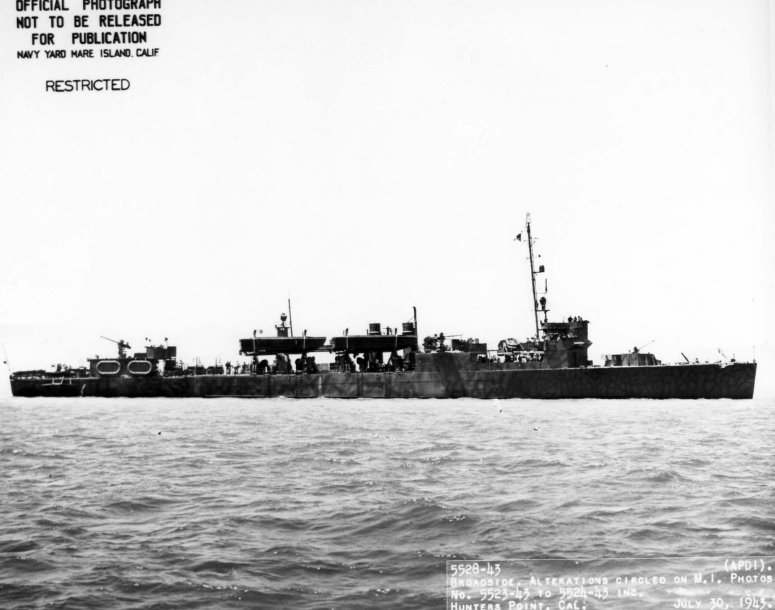
USS Manley after her last refit in 1945
On 4 January 1945 she took part in the landing on Lingayen Gulf, Luzon, and escorted a LST convoy to Leyte Gulf on 18 January.
She landed troops at Nasugbu, Luzon on 31 January and returned to Leyte, refuelled at Mindoro and escorted a convoy to Subic Bay.
She operated with TransDiv 100, carrying six LCI(L)s with 700 assault troops and landed them at Mariveles on 15 February and two days later at Corregidor. On 2 April she carried land-based planes to Okinawa, landed on 7 April 1945. Durin the trip back her sonar operator picked up a signal and she dropped depth charges on a posisble submarine, later screening USS White Plains (CVE-66) and USS Hollandia (CVE-97) to Guam.
The veteran was back to San Diego on 23 May for an overhaul, reclassified DD-74 on 25 June 1945. On 24 July she was sent to Pearl Harbor Navy Yard to be fitted with a catapult, in order to test target drones. Her frontline carrer came to an end. With this role, the old destroyer, last of her class still in service, helped to train gunners and face Kamikaze attacks, but the war ended and she was still in this role in the Hawaiian Islands when steaming on 26 September for San Diego, crossed the Panama Canal to Philadelphia NyD and decommission on 19 November 1945. Stricken on 5 December 1945 she was sold for scrap on 26 November 1946. For her career she earned 5 battle stars and a Navy Unit Commendation.


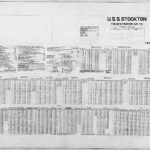
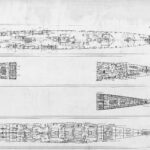
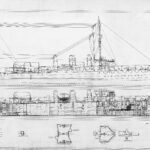
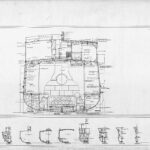
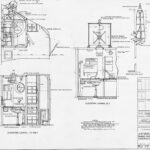
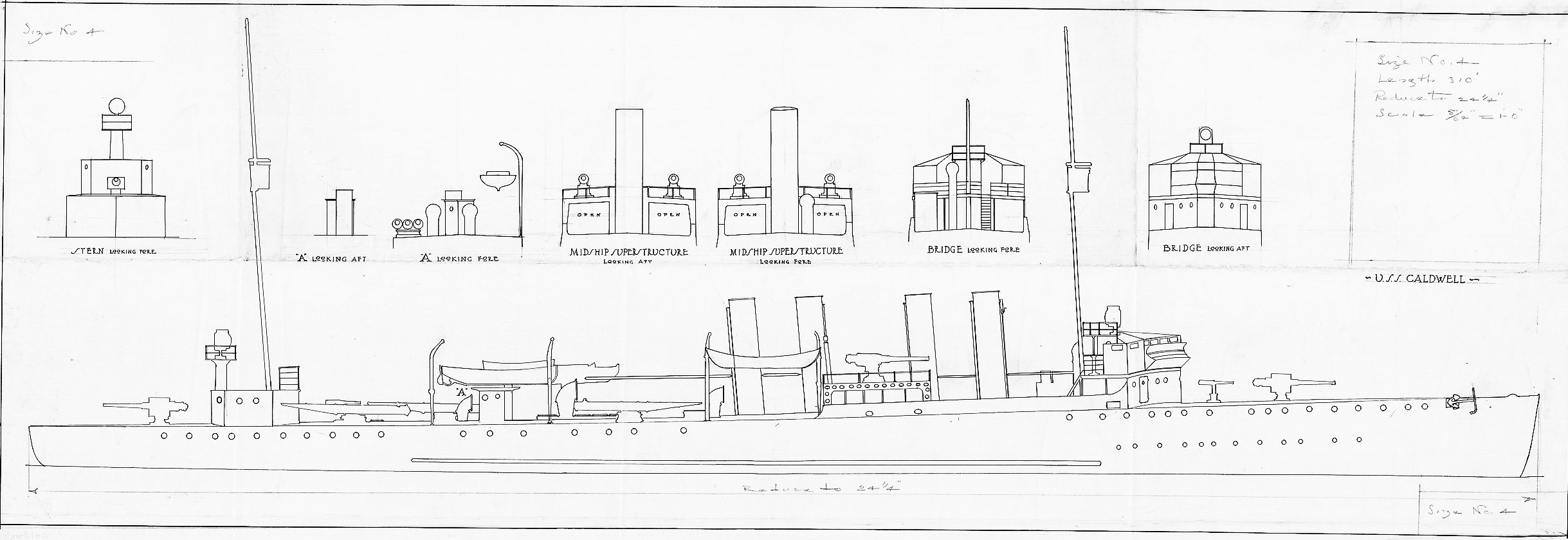
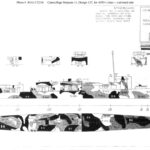
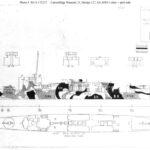
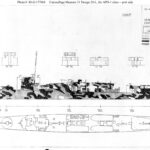

 Latest Facebook Entry -
Latest Facebook Entry -  X(Tweeter) Naval Encyclopedia's deck archive
X(Tweeter) Naval Encyclopedia's deck archive Instagram (@navalencyc)
Instagram (@navalencyc)





 French Navy
French Navy Royal Navy
Royal Navy Russian Navy
Russian Navy Armada Espanola
Armada Espanola Austrian Navy
Austrian Navy K.u.K. Kriegsmarine
K.u.K. Kriegsmarine Dansk Marine
Dansk Marine Nautiko Hellenon
Nautiko Hellenon Koninklije Marine 1870
Koninklije Marine 1870 Marinha do Brasil
Marinha do Brasil Osmanlı Donanması
Osmanlı Donanması Marina Do Peru
Marina Do Peru Marinha do Portugal
Marinha do Portugal Regia Marina 1870
Regia Marina 1870 Nihhon Kaigun 1870
Nihhon Kaigun 1870 Preußische Marine 1870
Preußische Marine 1870 Russkiy Flot 1870
Russkiy Flot 1870 Svenska marinen
Svenska marinen Søværnet
Søværnet Union Navy
Union Navy Confederate Navy
Confederate Navy Armada de Argentina
Armada de Argentina Imperial Chinese Navy
Imperial Chinese Navy Marinha do Portugal
Marinha do Portugal Mexico
Mexico Kaiserliche Marine
Kaiserliche Marine 1898 US Navy
1898 US Navy Sovietskiy Flot
Sovietskiy Flot Royal Canadian Navy
Royal Canadian Navy Royal Australian Navy
Royal Australian Navy RNZN Fleet
RNZN Fleet Chinese Navy 1937
Chinese Navy 1937 Kriegsmarine
Kriegsmarine Chilean Navy
Chilean Navy Danish Navy
Danish Navy Finnish Navy
Finnish Navy Hellenic Navy
Hellenic Navy Polish Navy
Polish Navy Romanian Navy
Romanian Navy Turkish Navy
Turkish Navy Royal Yugoslav Navy
Royal Yugoslav Navy Royal Thai Navy
Royal Thai Navy Minor Navies
Minor Navies Albania
Albania Austria
Austria Belgium
Belgium Columbia
Columbia Costa Rica
Costa Rica Cuba
Cuba Czechoslovakia
Czechoslovakia Dominican Republic
Dominican Republic Haiti
Haiti Hungary
Hungary Honduras
Honduras Estonia
Estonia Iceland
Iceland Eire
Eire Equador
Equador Iran
Iran Iraq
Iraq Latvia
Latvia Liberia
Liberia Lithuania
Lithuania Mandchukuo
Mandchukuo Morocco
Morocco Nicaragua
Nicaragua Persia
Persia San Salvador
San Salvador Sarawak
Sarawak Uruguay
Uruguay Venezuela
Venezuela Zanzibar
Zanzibar Warsaw Pact Navies
Warsaw Pact Navies Bulgaria
Bulgaria Hungary
Hungary

 Bundesmarine
Bundesmarine Dutch Navy
Dutch Navy Hellenic Navy
Hellenic Navy Marina Militare
Marina Militare Yugoslav Navy
Yugoslav Navy Chinese Navy
Chinese Navy Indian Navy
Indian Navy Indonesian Navy
Indonesian Navy JMSDF
JMSDF North Korean Navy
North Korean Navy Pakistani Navy
Pakistani Navy Philippines Navy
Philippines Navy ROKN
ROKN Rep. of Singapore Navy
Rep. of Singapore Navy Taiwanese Navy
Taiwanese Navy IDF Navy
IDF Navy Saudi Navy
Saudi Navy Royal New Zealand Navy
Royal New Zealand Navy Egyptian Navy
Egyptian Navy South African Navy
South African Navy






























 Ukrainian Navy
Ukrainian Navy dbodesign
dbodesign